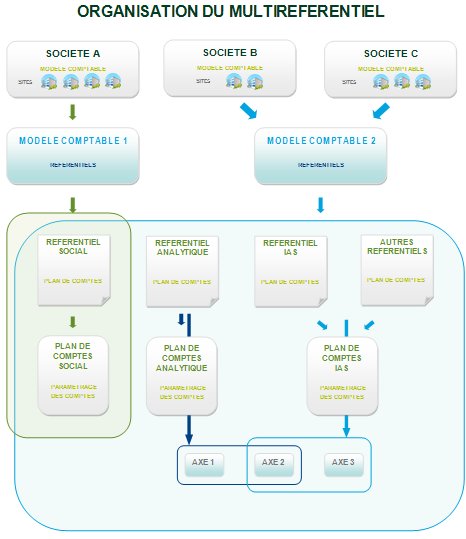Ledgers
A ledger features setup data associated with a chart of accounts.

The ledger mainly qualifies the general and/or analytical accounting type and contains the management rules connected with the matching and the end-of-year rules.
In the event of a general ledger, the chart of accounts that is going to be used must be associated and if it is a (purely or not) analytical general ledger, the dimension types must also be specified. A same dimension type code can be used in various ledgers belonging or not to the same model.
A same chart of accounts can be associated with various ledgers. For instance, within the same folder, a same chart of accounts can be associated with the social ledger for an American company and with the US GAAP reporting ledger type for a French company.
A general and analytical chart of accounts can be used in a ledger that is purely general, purely analytical or both.
Prerequisite
Refer to documentation Implementation
Screen management
Entry screen
Fields
The following fields are present on this tab :
Block number 1
|
Code of the current ledger. |
|
Standard title of the current record. |
Identification
|
The short description replaces the standard description when display or print constraints require it. By default the short title, the long title or the column header of a data are recorded (on creation/update) in the connection language of the user.
A user who logs on with this language will view the short description, long description or column header in their connection language if a translation exists. Otherwise, these descriptions will be available in the folder language.
|
|
Non-compulsory field containing the legislation code (miscellaneous table 909). The entered value is used upon creation and validation of the folder and upon addition of data during legislation copy. The data concerning the requested legislations and the common data (legislation code empty) on folder creation. Only the records concerning the folder legislations are retrieved on folder validation. The Legislation field is also used as a filter and checked upon movement selection and entry (entry of invoices, payments, journals etc.). If the field is empty, the current record can be used whatever the legislation of the company concerned by the movement. |
Type of accounting
|
The account core model must necessarily have a general ledger. If the ledger being created is a general ledger, the accounting types Budget, Operating budgets and Commitments cannot be accessed. |
|
The main analytical ledger must be checked 'Analytical'. A general ledger can also have the 'Analytical' box checked. |
|
A ledger can only manage budgets if it is an analytical ledger. |
|
A ledger can only manage operating budgets if it is an analytical ledger. |
|
A ledger can manage an account management of type 'Commitments' only if the ledger is analytical.
|
|
Click this check box to define this ledger as a Project management ledger.
|
|
Select this check box to allow consolidation management. An accounting core model can have several ledgers with this type of accounting. |
|
|
CoA and dimension types
|
Specify in this field the chart of accounts associated with the ledger. |
|
Specify the number of dimension views of the current ledger. |
|
Enter the code of the dimension types of the current ledger. |
Management
|
In a journal, the balance represents equal debits and credits in the transaction currency, irrespective of the site. |
|
If the chosen balance is to be considered by site, the journal must be balanced site by site. This balance is obtained by using the link accounts defined in the chart of accounts if the need arises. |
|
All general and/or analytical accounts can use matching. |
|
When this box is checked, it will be mandatory, for instance when entering an entry, to assign at least one dimension view for this ledger. |
|
This option can only be accessed if the option Mandatory dimension view entry is not checked. |
Fiscal year end
|
This option is used within the framework of the fiscal year-end process and it can take the following values:
The fiscal year-end processing function generates at least this Carry Forward Entry journal (GAUFIYEN setup). |
|
If the box balanced CFE is checked, in addition to the carry-forward entry journal, the processing will generate a result establishment entry (GAUFIYRE parameter). For a General Accounting ledger, the balanced CFE is requested. |
|
When the Closing journal checkbox is checked, a closure document for all accounts is created on the last day of the fiscal year. If the ledger is a general and analytical ledger, the journal closes all accounts and their analytical balances.
|
|
When a closing journal will be generated, the fiscal year end processing is likely to create:
When this box is checked, the program will create a closing journal by account. |
Close
Error messages
In addition to the generic error messages, the following messages can appear during the entry :
At least one dimension type must be entered
Chart of accounts incompatible
Impossible to change the chart of accounts or the dimension types
This message appears whenever a movement is saved for the ledger under modification.


